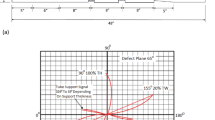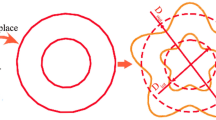Abstract
Composite materials have excellent potential in automobile industry for energy absorption due to their superior characteristics in terms of energy absorption per unit mass compared to traditional metallic materials. Holes may represent an extreme case of impact damage that perforates the tube, e.g., stones from road surface impacting the tubes. Tubes with holes represent a more conservative performance characteristics since impact damage of the same size will have residual material which may carry some load. Tubes with holes can provide the lower limit of carbon fiber reinforced plastics tube performance under axial crushing relative to impact damaged tubes with perforation diameter close to the hole diameter. Dynamic response of tubes with and without holes have been experimentally characterized and then predicted using LSDYNA software. The performance of regular tubes and tubes with holes (15 mm dia) were similar and both tubes were able to absorb energy close to 53 kJ/kg. The size of the hole and its location chosen for this particular study did not appreciably affect the dynamic tube performance and both types of the tubes crushed in a progressive manner. The specific energy absorption values from experimental and computational results were found to be within 10% and average crushing load, Pmean values were within 8% for both regular tubes and tubes with holes. Considering the complexity in failure modes, correlations between experimental and modeling results are considered very good for prediction of the dynamic response of the tubes.













Similar content being viewed by others
Data availability
Data from this publication is available to readers.
References
Hull D (1991) A unified approach to progressive crushing of fiber reinforced composite tubes. Compos Sci Technol 40:377–421
Thornton PH, Jeryan RA (1988) Crash energy management in composite automotive structures. Int J Impact Eng 7(2):167–180
Thornton PH (1979) Energy absorption of composite structures. J Compos Mater 13:247–262
Thornton PH (1990) The crush behavior of pultruded tubes at high strain rates. J Compos Mater 24:594–615
Tao WH, Robertson RE, Thornton PH (1993) Effects of materials properties and crush conditions on the crush energy absorption of fiber composite rods. Compos Sci Technol 47:405–418
Farley GL (1983) Energy absorption of composite materials. J Compos Mater 17:267–279
Farley GL (1986) Effect of fiber and matrix maximum strain on the energy absorption of composite materials. J Compos Mater 20:322–334
Farley GL (1986) Effect of specimen geometry on the energy absorption capability of composite materials. J Compos Mater 20:390–400
Hamada H, Ramakrishna S (1996) Effect of fiber material on the energy absorption behavior of thermoplastic composite tubes. J Thermoplast Compos Mater 9:259–279
Ramakrishna S, Hamada H, Maekawa Z, Sato H (1995) Energy absorption behavior of carbon-fiber-reinforced thermoplastic composite tubes. J Thermoplast Compos Mater 8:323–344
Hamada H, Ramakrishna S, Sato H (1996) Effect of fiber orientation on the energy absorption capability of carbon fiber/PEEK composite tubes. J Compos Mater 30:947–963
Hamada H, Ramakrishna S (1995) Scaling effects in the energy absorption of carbon-fiber/PEEK composite tubes. Compos Sci Technol 55:211–221
Mamalis AG, Manolakos DE, Viegelahn GL (1990) Crashworthy behavior of thin-walled tubes of fiberglass composite material subjected to axial loading. J Compos Mater 24:72–91
Mamalis AG, Manolakos DE, Demosthenous GA, Ioannidis MB (1995) The deformation mechanism of thin-walled non-circular composite tubes subjected to bending. Compos Struct 30:131–146
Czaplicki MJ, Robertson RE, Thornton PH (1991) Comparison of bevel and tulip triggered pultruded tubes for energy absorption. Compos Sci Technol 40:31–46
Abdel-Haq M, Newaz GM (2001) Role of failure modes on energy absorption in unidirectional PMC tubes. J Compos Mater 35(11):941–953
Abdel-Haq M, Newaz GM (2001) Influence of crush mechanisms on energy absorption of PMC square tubes. J Thermoplast Compos Mater 14(2):160–174
Abdel-Haq M, Broggiato GB, Newaz GM (1991) Constraint effects on energy absorption in unidirectional PMC tubes. J Compos Mater 33(9):774–793
Fontana Q (1990) Speed and temperature effects in energy absorption of axially crushed composite tubes. Ph. D. Thesis, University of Cambridge
Saha M, Prabhakaran R, Waters WA Jr (2004) Compressive behavior of pultruded composite plates with circular holes. Compos Struct 65:29–36
Van Tooren MJL, Van Stijn IPM, Beukers A (2002) Curvature effects on the stress distribution in sandwich cylinders with a circular cut-out. Compos A 33:1557–1572
Quinn S, Dulieu-Barton JM (2002) Determination of stress concentration factors for holes in cylinders using thermoelastic stress analysis. Blackwell Sci Strain 38:105–118
Wu H-C, Mu B (2003) On stress concentrations for isotropic/orthotropic plates and cylinders with a circular hole. Compos B 34:127–134
Siromani D, Awerbach J, Tan T-M (2014) Finite element modeling of the crushing behavior of thin-walled CFRP tubes under axial compression. Compos B 54:50–58
LS-DYNA Keyword User’s Manual (2006) Version 971. Livermore Software Technology Corporation, Livermore, USA
Bisagni C, Pietro GP, Fraschini L, Terletti D (2005) Progressive crushing of fiber- reinforced composite structural components of a Formula One racing car. Compos Struct 68(4):491–503
Huang J, Wang X (2009) Numerical and experimental investigations on the axial crushing response of composite tubes. Compos Struct 91(2):222–228
Mamalis AG, Manolakos DE, Ioannidis MB, Papapostolou DP (2006) The static and dynamic axial collapse of CFRP square composite tubes: finite element modeling. Compos Struct 74(2):213–225
Palanivelu S, Paepegem W, Degrieck J, Kakogiannis D, Ackeren J, Hemelrijck D (2010) Parametric study of crushing parameters and failure patterns of pultruded composite tubes using cohesive elements and seam, part I: central delamination and triggering modeling. Polym Test 29(6):729–741
Palanivelu S, Paepegem W, Degrieck J, Kakogiannis D, Ackeren J, Hemelrijck D (2010) Parametric study of crushing parameters and failure patterns of pultruded composite tubes using cohesive elements and seam, part II: multiple delaminations and initial geometric imperfections. Polym Test 29(7):803–814
Alhiyari O, Begeman P, Newaz G (2021) Energy absorption in carbon fiber composites with holes under quasi-static loading. Carbon 7(1):16. https://doi.org/10.3390/c7010016
Alhiyari O (2021) Effect of holes on energy absorption of carbon fiber composites. PhD Thesis, Wayne State University, Detroit, MI. https://www.proquest.com/docview/2540820042?pq-origsite=gscholar&fromopenview=true
Bonora N, Testa L, Newaz G (2000) FEM simulation of failure modes in composite tubes for automotive crush energy absorption. In Proceedings of the American Society for Composites, pp. 1216–1224
Funding
The research work was funded through Wayne State University.
Author information
Authors and Affiliations
Corresponding author
Ethics declarations
Conflict of interest
None of the co-authors had any conflict of interest in conducting the research program or afterwards.
Additional information
Publisher's Note
Springer Nature remains neutral with regard to jurisdictional claims in published maps and institutional affiliations.
Rights and permissions
Springer Nature or its licensor (e.g. a society or other partner) holds exclusive rights to this article under a publishing agreement with the author(s) or other rightsholder(s); author self-archiving of the accepted manuscript version of this article is solely governed by the terms of such publishing agreement and applicable law.
About this article
Cite this article
Newaz, G., Alhyari, O. & Begeman, P. Energy Absorption in CFRP Tubes Under Dynamic Loading. J. dynamic behavior mater. 10, 40–50 (2024). https://doi.org/10.1007/s40870-023-00398-3
Received:
Accepted:
Published:
Issue Date:
DOI: https://doi.org/10.1007/s40870-023-00398-3




